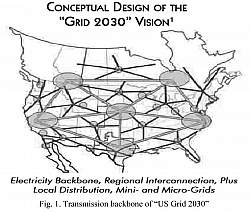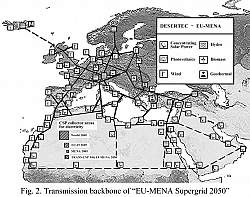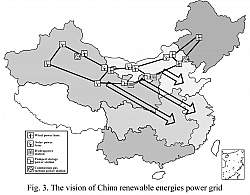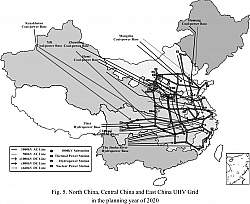Several Power Transmission Backbone Schemes
Abstract :
Several power transmission backbone schemes in the future are introduced or proposed in this paper, including asynchronous interconnected power grid of “US Grid 2030”, the Europe, Middle East and North Africa Supergird and a vision of China wide-area renewable energies power grid, as well as ultra-high voltage power grids of China and India
by Yutian Liu, Dong Yang and Hong Chen
The transmission backbone of the 21st century must attach the smart features :
1) self-healing: enabling the electricity network reconfigure itself dynamically and quickly to recover from deliberate attacks, natural disasters or network components failures
2) accessible: granting connection access to all network users, particularly for renewable power sources and high efficiency generation with zero or low carbon emissions
3) efficient: improving the transmission capability as fully as possible to meet increased consumer demands without adding new infrastructures
ASYNCHRONOUS INTERCONNECTED POWER GRID - US 2030
The free network structure, in essence, is just the reason why accidental faults possibly trigger load transfer and chain reaction. The 2030 nation-wide backbone like a pentagon has the ability to balance power supply and demand in the wide area, where season, weather and other differences are available to provide complementary effects. Below the backbone, local distribution grids, mini-grids and micro-grids are interconnected with each other through radial DC lines, thus realizing the hierarchy and partition, reducing the blackout scope and improving the emergency support.
WIDE-AREA RENEWABLE ENERGIES POWER GRID - EU 2050 (cf OMA research)
On the basis of European vision for electricity networks of 2050, the 100GW North Sea Supergrid will be combined with the large solar power project, which Germany started in the Sahara Desert in October 2009. The supergrid is to be gradually expanded into a wider area covering Europe, Middle East and North Africa. By 2050, the large solar power project in the desert, so called “Concentrating Solar Thermal Power + Seawater Desalination”, is expected to transmit 50~200GW power to Europe.
CHINA RENEWABLE ENERGIES POWER GRID
According to preliminary estimate, China will have a total installed capacity of 2400GW by 2050, approximate 30% of which from non-water renewable energies. By 2050, the large-scale wind power sent from the northwest, North China and northeast region will reach the 100-million-kW level, including 12.7GW in Jiuquan, Gansu, 20GW in Hami, Xinjiang, 20GW in the west of Inner Mongolia, 30GW in the east of Inner Mongolia and 10GW in the north of Hebei.
CHINA ULTRA-HIGH VOLTAGE POWER GRID
More than 70% of coal resources and most non-water renewable energies are in Inner Mongolia, Shanxi, Shaanxi, Gansu, Xinjiang and other northern areas. More than 80% of water resources are in Sichuan, Yunnan, Tibet and other southwest areas. However, two-thirds of energy demands are located in the east and middle.
CONCLUSIONS
1) “US Grid 2030” divides 3 former synchronous systems into more small parts that are isolated, controlled and mutual supported through DC links, thereby greatly lowering the large-scale blackout risk.
2) If a wide-area renewable energies power grid can be built, the intermittence and instability of new energies will be relieved depending on energy resources complementarities in the expanse, thus reducing the investments of energy storage installations to a large extent.
3) UHV grids in India and China have the ability to provide a strong supporting framework for the huge-scale UHVDC power. Meanwhile, to reduce the blackout scope for UHV grids is also necessary and challenging. This work will be helpful to draw the big picture of power transmission backbone in the future.
Files
- 182.pdf (PDF / 745.74 KB)




